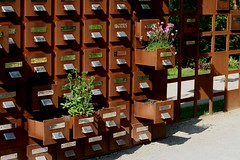I’m wondering if anyone out there has any particular
insights into the varying mission and functions of an archive versus an institutional
repository. I thought I had a very clear idea in my head about what an
institutional repository is, or at least its purpose. However, when I began to
discuss this with my university’s archivist, her response was, “We already have
an institutional repository—it’s called the archive!” This stumped me a bit. I
don’t think they are the same thing, but it has been difficult to articulate
the key differences.
After doing a little bit of research (Google was
spectacularly unhelpful in this particular case) and some further discussions
with our archivist, I have some coherent thoughts forming. I think archives and
institutional repositories have related, but distinct purposes, which inform
their policies and practices around content, preservation, and access.
Content
University archives
collect a couple different kinds of content, including administrative records
and materials relating to the history and accomplishments of the university and
its members. While there may be legally required collections policies on
administrative records, universities and their archivists generally have a fair
amount of discretion when it comes to what to collect. Finally, in most
institutions the archives were created in a pre-digital era, many of the
objects in the archive were and continue to be physical. The shift to digital
means a couple thing, one that archive catalogs are more likely to be online
(just as with libraries), and two that archives must develop new policies for
preserving objects that were “born digital”.
Institutional
repositories collect the intellectual and scholarly output of a university.
This may mean works published elsewhere, informally published works, grey
literature, or work not formerly published. It is harder to make universal
statements about what does or does not belong in an IR, because universities
seem to use them different, however best fits their needs. I’ve seen examples
of IR software that contain image collections and audio/visual collections. I
would like to say that most of the materials in IR are “born digital”, but I’ve
seen IRs that have digitized versions of old campus blueprints—something that
seems more like an archival object to me.
Preservation or
Access?
My crude, simplistic assessment of the major difference
between archives and institutional repositories is that archives are more
concerned with preservation and IRs are primarily about providing access. The
two are clearly not mutually exclusive, in fact, one could ask what the point
of preservation would be if not to provide future access, but that is just the
librarian in me. However, when I look at the policies, practices, and opinions
from these two communities, archivists and scholarly communication folks, this
seems to be the key difference.
The work of archivists is to ensure the long-term
preservation of objects, often physical objects that are irreplaceable. They
are concerned with original object, accession order, and provenance. While
online archive catalogs have enabled more access points for searching and
finding documents, archival cataloging is chiefly concerned with office of
origin and date of creation. Compare this to library catalogs, even prior to
the move online library catalogs still provided access points for author,
title, and subject.
In my mind institutional repositories are inextricably
related to the open access movement. While they may serve the related purpose
of preserving scholarship, their chief purpose is to provide access to that
work. Scholars and librarians have advocated and created IRs in explicit
opposition to disturbing trends in the scholarly publishing industry.
What do you think? Are there other important differences
between archives and institutional repositories? Or am I trying to create false
distinctions between two things that are really the same?


